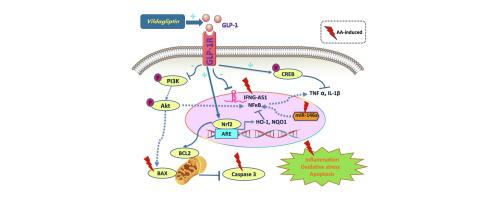International Immunopharmacology ( IF 5.6 ) Pub Date : 2021-01-09 , DOI: 10.1016/j.intimp.2020.107354 Marina R Fouad 1 , Rania M Salama 2 , Hala F Zaki 3 , Ayman E El-Sahar 3

|
Inflammatory processes, including ulcerative colitis (UC), are associated with the increase in synthesis and release of pro-inflammatory cytokines. The release of these cytokines is regulated by phosphatidylinositol-3-kinase (PI3K)/protein kinase B (Akt)/nuclear factor-kappa B (NFκB) and cAMP response element-binding protein (CREB) signaling pathways as well as over expression of microRNA 146a (miR-146a) and long non-coding RNA interferon gamma antisense 1 (lncRNA IFNG-AS1). Vildagliptin (Vilda), a dipeptidyl peptidase IV (DPP-IV) inhibitor, has an anti-inflammatory, antioxidant and anti-apoptotic effects which were established in various models. However, its possible protective effect in UC has not been clarified. Hence, the current study aimed to explore the possible prophylactic effect of different doses of Vilda against acetic acid (AA)-induced colitis in rats. Forty-eight adult Wistar rats were divided into six groups: control, Vilda (10 mg/kg/day; p.o.), AA, AA + Vilda (5 mg/kg/day; p.o.), AA + Vilda (10 mg/kg/day; p.o.) and AA + sulfasalazine (Sulfa) (100 mg/kg/day; p.o.). Low- and high-dose Vilda showed significant improvement in the disease activity index (DAI) and macroscopic assessment markers. Vilda has markedly inhibited the expression of lncRNA IFNG-AS1 and miR-146a, as well as PI3K/Akt/NFκB pathway, while activated CREB and nuclear factor erythroid 2-related factor 2 (Nrf2) signaling pathways, and this was reflected in alleviated oxidative stress, inflammation and apoptosis. Such outcomes were more prominent with the high-dose Vilda versus low-dose Vilda and Sulfa. Moreover, the histological examination showed almost intact histological features in Vilda-treated groups when compared to AA group treated with saline. In conclusion, Vilda can be regarded as a new promising therapeutic alternative against UC.
中文翻译:

维格列汀通过靶向PI3K / Akt /NFκB,Nrf2和CREB信号通路以及lncRNA IFNG-AS1和miR-146a的表达来减轻乙酸诱发的大鼠结肠炎
包括溃疡性结肠炎(UC)在内的炎症过程与促炎细胞因子的合成和释放增加有关。这些细胞因子的释放受磷脂酰肌醇3激酶(PI3K)/蛋白激酶B(Akt)/核因子-κB(NFκB)和cAMP反应元件结合蛋白(CREB)信号通路的调控,以及它们的过度表达microRNA 146a(miR-146a)和长的非编码RNA干扰素γ反义1(lncRNA IFNG-AS1)。维达列汀(Vilda)是一种二肽基肽酶IV(DPP-IV)抑制剂,具有抗炎,抗氧化和抗凋亡的作用,已在各种模型中建立了这种作用。但是,其在UC中可能的保护作用尚未阐明。因此,当前的研究旨在探讨不同剂量的Vilda对乙酸(AA)诱导的大鼠结肠炎的预防作用。48只成年Wistar大鼠分为六组:对照组,Vilda(10 mg / kg /天;口服),AA,AA + Vilda(5 mg / kg /天;口服),AA + Vilda(10 mg / kg) /天; po)和AA +柳氮磺吡啶(Sulfa)(100 mg / kg /天; po)。低剂量和高剂量Vilda在疾病活动指数(DAI)和宏观评估指标上显示出显着改善。Vilda显着抑制了lncRNA IFNG-AS1和miR-146a以及PI3K / Akt /NFκB通路的表达,同时激活了CREB和核因子红系2相关因子2(Nrf2)信号通路,这在缓解方面得到了体现。氧化应激,炎症和细胞凋亡。高剂量的Vilda与低剂量的Vilda和Sulfa相比,这种结果更为突出。而且,与用盐水处理的AA组相比,组织学检查显示在Vilda处理的组中几乎完整的组织学特征。总之,Vilda可以被视为对抗UC的新的有希望的治疗选择。



























 京公网安备 11010802027423号
京公网安备 11010802027423号